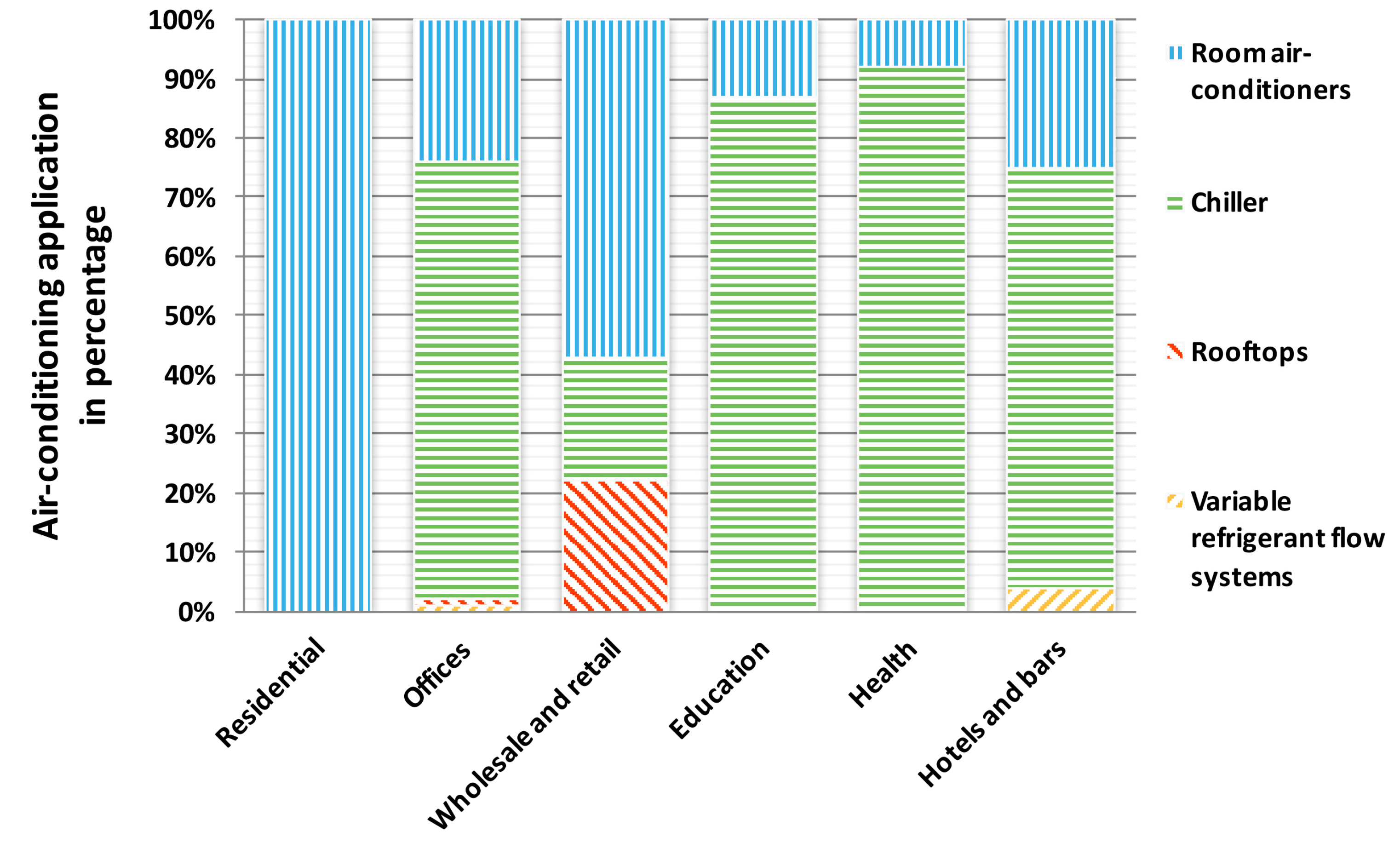Status Quo of the Air-Conditioning Market in Europe: Assessment of the Building Stock
Abstract
:1. Introduction
2. Materials and Methods
- Split systems (A);
- Multisplit systems (B);
- Single-duct systems (C);
- Packed units (D);
- Variable refrigerant flow systems (E);
- Rooftops (F);
- Chiller (G).
- Residential sector: includes occupied or unoccupied dwellings (single-family houses, multi-family houses and apartment blocks) and mobile homes. Institutional housing such as school dormitories, hostels, hotels, health, military barracks, and night shelters are excluded;
- Offices: composed of private company and public sector offices;
- Wholesale and retail: consists of detached shops, department stores, shopping centers, retail, food shops, car sales and maintenance, bakeries, hairdresser, service stations, laundries, congress and fair buildings, and other wholesale and retail infrastructures;
- Education: contains primary, secondary and high schools. Furthermore, also universities, infrastructure for professional training activities, and research centers/laboratories are part of this sector;
- Health: comprises private and public health, homes for handicapped, medical care and nursery;
- Hotels and bars: include hotels, cafés, pubs, restaurants, canteens, and catering in business.
3. Results
4. Discussion and Conclusions
Acknowledgments
Author Contributions
Conflicts of Interest
Appendix A
| Sector | Cooled Floor Area | Standard Deviation | Average | Result | ||
|---|---|---|---|---|---|---|
| Residential | 1696 | 1073 | 1932 | 444 | 1567 | 1814 |
| Offices | 985 | 645 | 756 | 174 | 795 | 700 |
| Wholesale and retail | 864 | 869 | 840 | 15 | 858 | 866 |
| Education | 369 | 411 | 352 | 30 | 377 | 360 |
| Health | 350 | - | - | - | 350 | 350 |
| Hotels and bars | 278 | 350 | 347 | 40 | 325 | 348 |
| Sector | Equivalent Full-Load Hours | Standard Deviation | Average | Result | ||
|---|---|---|---|---|---|---|
| Residential | 519 | 610 | 500 | 59 | 543 | 510 |
| Offices | 803 | 874 | 866 | 39 | 848 | 870 |
| Wholesale and retail | 1019 | 1026 | 1200 | 103 | 1082 | 1023 |
| Education | 300 | - | - | - | 300 | 300 |
| Health | 1000 | - | - | - | 1000 | 1000 |
| Hotels and bars | 751 | 768 | 711 | 29 | 743 | 760 |
| AC Type | Installed Air-Conditioners | Standard Deviation | Average | Result | |||
|---|---|---|---|---|---|---|---|
| Split systems | 23.96 | 39.17 | 36.60 | - | 8.14 | 33.24 | 37.89 |
| Multisplit systems | 1.74 | 2.84 | 3.60 | - | 0.94 | 2.73 | 3.22 |
| Single-duct systems | 5.92 | 9.68 | 9.60 | - | 2.15 | 8.40 | 9.64 |
| Packed | 6.64 | 10.86 | 10.20 | - | 2.27 | 9.23 | 10.53 |
| VRF | 0.52 | 0.85 | 0.59 | - | 0.17 | 0.65 | 0.55 |
| Rooftops | 0.16 | 0.26 | 0.21 | 0.20 | 0.04 | 0.21 | 0.21 |
| Chiller | 1.06 | 1.73 | 1.30 | 1.09 | 0.31 | 1.30 | 1.15 |
| AC Type | Capacity | Standard Deviation | Average | Result | |||
|---|---|---|---|---|---|---|---|
| Split systems | 4.00 | 3.00 | 3.50 | - | 0.50 | 3.50 | 3.50 |
| Multisplit systems | 19.80 | 15.75 | 16.30 | - | 2.20 | 17.28 | 16.03 |
| Single-duct systems | 10.58 | 10.38 | 12.67 | - | 1.27 | 11.21 | 10.48 |
| Packed | 5.00 | 5.40 | 4.65 | 4.60 | 0.37 | 4.91 | 4.75 |
| VRF | 20.40 | 22.20 | 29.00 | - | 4.54 | 23.87 | 21.30 |
| Rooftops | 42.30 | 51.00 | 39.00 | - | 6.20 | 44.10 | 40.65 |
| Chiller | 136.40 | 187.00 | 135.00 | - | 29.63 | 152.80 | 135.70 |
| AC Type | Seasonal Energy Efficiency Ratio | Standard Deviation | Average | Result | ||||
|---|---|---|---|---|---|---|---|---|
| Split systems | 3.00 | 3.24 | 2.43 | 3.25 | 3.40 | 0.38 | 3.1 | 3.22 |
| Multisplit systems | 1.98 | 2.25 | - | - | - | 0.19 | 2.1 | 2.12 |
| Single-duct systems | 1.68 | 2.60 | 2.20 | - | - | 0.46 | 2.2 | 2.40 |
| Packed | 1.98 | 2.25 | 2.88 | - | - | 0.46 | 2.4 | 2.12 |
| VRF | 3.45 | 2.80 | - | - | - | 0.46 | 3.1 | 3.13 |
| Rooftops | 1.97 | 2.25 | 1.95 | - | - | 0.17 | 2.1 | 1.96 |
| Chiller | 3.93 | 3.25 | 3.27 | 3.10 | 3.14 | 0.34 | 3.3 | 3.19 |
References
- 2020 Climate & Energy Package. Available online: http://ec.europa.eu/clima/policies/strategies/2020/index_en.htm (accessed on 17 June 2017).
- 2030 Climate & Energy Framework. Available online: http://ec.europa.eu/clima/policies/strategies/2030/index_en.htm (accessed on 17 June 2017).
- European Europe 2020 Indicators—Climate Change and Energy. Available online: http://ec.europa.eu/eurostat/statistics-explained/index.php/Europe_2020_indicators_-_climate_change_and_energy (accessed on 17 June 2017).
- Benejam, G.M.; Mata, É.; Kalagasidis, A.S.; Johnsson, F. Bottom-up characterization of the Spanish building stock for energy assessment and model validation. In Proceedings of the Retrofit 2012 Conference, Manchester, UK, 24–26 January 2012. [Google Scholar]
- Consumption of Energy. Available online: http://ec.europa.eu/eurostat/statistics-explained/index.php/Consumption_of_energy (accessed on 17 June 2017).
- Economidou, M. Energy performance requirements for buildings in Europe. REHVA J. 2012, 92, 16–21. [Google Scholar]
- Energy Efficiency Trends in Buildings in the EU. Available online: https://energiatalgud.ee/img_auth.php/6/68/Enerdata._Energy_Efficiency_Trends_in_Buildings_in_the_EU._2012.pdf (accessed on 17 June 2017).
- Aebischer, B.; Catenazzi, G.; Jakob, M. Impact of climate change on thermal comfort, heating and cooling energy demand in Europe. Energy Effic. Build. 2007, 92, 859–870. [Google Scholar]
- Data Service. Available online: http://wds.iea.org/WDS/Common/Login/login.aspx (accessed on 17 June 2017).
- Research and Innovation. Available online: https://ec.europa.eu/research/energy/eu/index_en.cfm?pg=projects&fp7page=10 (accessed on 17 June 2017).
- Vinnova. H2020 Visualization. Available online: http://h2020viz.vinnova.se/#/ (accessed on 21 June 2017).
- Pezzutto, S. Analysis of the space heating and cooling market in Europe. Ph.D. Thesis, University of Natural Resources and Life Sciences, Vienna, Austria, 22 May 2014. [Google Scholar]
- Field Benchmarking and Market Development for Audit Methods in Air Conditioning. Available online: https://ec.europa.eu/energy/intelligent/projects/en/projects/auditac (accessed on 21 June 2017).
- Harmonizing Air-Conditioning Inspection and Audit Procedures in the Tertiary Building Sector. Available online: https://ec.europa.eu/energy/intelligent/projects/en/projects /harmonic (accessed on 21 June 2017).
- Energy Efficiency of Room Air-Conditioners. Available online: http://s3.amazonaws.com/zanran_storage/www.coolregion.fr/ContentPages/46076446.pdf (accessed on 21 June 2017).
- Energy Efficiency and Certification of Central Air Conditioners. Available online: http://lms.i-know.com/pluginfile.php/28688/mod_resource/content/57/Energy Efficiency and Certification of Central Air Conditioners.pdf (accessed on 21 June 2017).
- Limiting the Impact of Increasing Cooling Demand in the European Union: Results from a Study on Room Air-Conditioner Energy Efficiency RAC Types and Technology. Available online: http://aceee.org/files/proceedings/2000/data/papers/SS00_Panel10_Paper01.pdf (accessed on 21 June 2017).
- National and EU Wide Efforts to Increase Energy Efficiency of Installed Air Conditioners. Available online: http://www.cardiff.ac.uk/archi/research/auditac/pdf/auditac_national_eu.pdf (accessed on 21 June 2017).
- CIRCABC (Communication and Information Resource Centre for Administration, Businesses and Citizens). Available online: https://circabc.europa.eu/faces/jsp/extension/wai/navigation/container.jsp (accessed on 25 July 2017).
- Solar Air-Conditioning: It’s About Time. Available online: http://www.solair-project.eu/ (accessed on 21 June 2017).
- Multi-Level Actions for Enhanced Heating and Cooling Plans. Available online: http://stratego-project.eu/project-brief/ (accessed on 24 July 2017).
- The Market Potential of Micro-CHCP. Available online: http://www.solarthermalworld.org/sites/gstec/files/WP2_Market_Study_Final_Report_v10_Final.pdf (accessed on 18 June 2017).
- Development of Systematic Packages for Deep Energy Renovation of Residential and Tertiary Buildings Including Envelope and Systems. Available online: http://inspirefp7.eu/ (accessed on 24 July 2017).
- Melograno, P.N.; Pezzutto, S. IEA ANNEX 34 Italian Country Report; EURAC Research: Bolzano, Italy, 2010. [Google Scholar]
- Heat Roadmap Europe. Available online: http://www.heatroadmap.eu/heat-roadmap-europe-4.php (accessed on 24 July 2017).
- Pezzutto, S.; Fazeli, R.; De Felice, M.; Sparber, W. Future development of the air-conditioning market in Europe: An outlook until 2020. Wiley Interdisciplin. Rev. Energy Environ. 2016, 5, 649–669. [Google Scholar] [CrossRef]
- Renewable Smart Cooling for Urban Europe. Available online: http://www.rescue-project.eu/fileadmin/user_files/WP2_Reports/RESCUE_WP_2.3_EU_COOLING_MARKET.pdf (accessed on 18 June 2017).
- World Air Conditioning Market Grows Thanks to Hot Spots. Available online: https://www.bsria.com/news/article/world-air-conditioning-market-grows-thanks-to-hot-spots/ (accessed on 18 June 2017).
- Common Vision for the Renewable Heating & Cooling sector in Europe. Available online: http://www.rhc-platform.org/fileadmin/Publications/RHC_BROCHURE_140311_web.pdf (accessed on 18 June 2017).
- Europe HVAC Market by Product Type, By End Use Sector, By Country Competition Forecast & Opportunities. Available online: http://www.prnewswire.com/news-releases/europe-hvac-market-by-product-type-by-end-use-sector-by-country-competition-forecast--opportunities-2012-2022-300403859.html (accessed on 18 June 2017).
- Research and Markets: Air Conditioning Systems. Available online: http://www.businesswire.com/news/home/20120220005473/en/Research-Markets-Air-Conditioning-Systems-Global (accessed on 18 June 2017).
- Tobin, M.J. Principles and Practice of Mechanical Ventilation, 3rd ed.; McGraw-Hill Education: Chicago, IL, USA, 2012; pp. 242–243. ISBN 978-0071736268. [Google Scholar]
- Potential of Solar Thermal in Europe. Available online: http://eeg.tuwien.ac.at/eeg.tuwien.ac.at_pages/publications/pdf/WER1.pdf (accessed on 20 June 2017).
- Task 38 Solar Air-Conditioning and Refrigeration State of the Art on Existing Solar Heating and Cooling Systems A Technical Report of Subtask B. Available online: http://archive.iea-shc.org/publications/downloads/Report_B1_final.pdf (accessed on 21 June 2017).
- Thermally Driven Heat Pumps. Available online: https://hub.globalccsinstitute.com/publications/strategic-research-priorities-cross-cutting-technology/43-thermally-driven-heat-pumps (accessed on 21 June 2017).
- Energy Consumption in the Services Sector Surveys of EU Member States. Available online: http://ec.europa.eu/eurostat/documents/3217494/5634673/KS-43-02-042-EN.PDF/32e10ad4-43a3-4635-97f3-01b28ed6ba18 (accessed on 20 June 2017).
- American Society of Heating, Refrigeration, and Air Conditioning Engineers. Heating, Ventilating, and Air-conditioning Systems and Equipment; ASHRAE: New York, NY, USA, 2012; pp. 124–136. ISBN 9781936504268. [Google Scholar]
- ASHRAE. HVAC Systems and Equipment; ASHRAE: New York, NY, USA, 2016; pp. 87–92. ISBN 9781939200273. [Google Scholar]
- Europe’s Buildings under the Microscope. Available online: http://bpie.eu/wp-content/uploads/2015/10/HR_EU_B_under_microscope_study.pdf (accessed on 20 June 2017).
- Performance Rating of Unitary Air-Conditioning & Air-Source Heat Pump Equipment. Available online: http://www.ahrinet.org/App_Content/ahri/files/standards%20pdfs/ANSI%20standards%20pdfs/ANSI.AHRI%20Standard%20210.240%20with%20Addenda%201%20and%202.pdf (accessed on 18 June 2017).
- Pezzutto, S. Analysis of the Space Heating and Cooling Market in Europe. Int. J. Contemp. Energy 2016, 2. [Google Scholar] [CrossRef]
- European Demography. Available online: http://ec.europa.eu/eurostat/documents/2995521/ 5037986/3-28072011-AP-EN.PDF/2d0d6e39-1e13-46a5-abb2-4a52c650ee81 (accessed on 21 June 2017).
- Inspection and Audit of Air Conditioning Facilities. Available online: https://ec.europa.eu/energy/intelligent/projects/sites/iee-projects/files/projects/documents/auditac_training_package.pdf (accessed on 21 June 2017).
- Adnot, J.; Giraud, D.; Colomines, F.; Rivière, P.; Becirspahic, S.; Benke, G. Central (commercial) airconditioning systems in Europe. Proceedings 2002, 5, 143–149. [Google Scholar]
- Analyse des Energieverbrauchs von Wiener Krankenanstalten. Available online: https://www.energyagency.at/fileadmin/dam/pdf/projekte/gebaeude/HEALTH-Analyse-Energieverbrauch.pdf (accessed on 20 June 2017). (In Language).
- Valutazione dei Consumi Nell’Edilizia Esistente e Benchmark Mediante Codici Semplificati: Analisi di Edifici Ospedalieri. Available online: http://www.enea.it/it/Ricerca_sviluppo/documenti/ricerca-di-sistema-elettrico/governance/rse117.pdf (accessed on 20 June 2017). (In Language).
- De Luca, A. Performance evaluation of Thermally Driven Heat Pumps integrated in Innovative Energy Systems for Buildings air-Conditioning. Master’s Thesis, Free University of Bolzano-Bozen, Faculty of Science and Technology, Bolzano-Bozen, Italy, 2012. [Google Scholar]
- Energy Efficiency Trends for Households in the EU. Available online: http://www.odyssee-mure.eu/publications/efficiency-by-sector/household/household-eu.pdf (accessed on 21 June 2017).
- Quantifying the Heating and Cooling Demand in Europe. Available online: http://stratego-project.eu/wp-content/uploads/2014/09/STRATEGO-WP2-Background-Report-4-Heat-Cold-Demands.pdf (accessed on 21 June 2017).
- Werner, S. European space cooling demands. Energy 2016, 110, 148–156. [Google Scholar] [CrossRef]
- School Year and Summer Vacation—History. Available online: https://www.infoplease.com/history-summer-vacation (accessed on 21 June 2017).
- A Brief History of: Summer Vacation. Available online: http://content.time.com/time/magazine/article/0,9171,1816501,00.html (accessed on 22 June 2017).
- School Holiday Dates in Europe: UK, England, France, Netherlands, Germany and Much More. Available online: https://www.schoolholidayseurope.eu/ (accessed on 22 June 2017).
- Market Report for Small and Medium-Sized Solar Air-Conditioning Appliances Analysis of Market Potential. Available online: http://www.ee.fs.uni-lj.si/solair/Market_analysis_EN.pdf (accessed on 22 June 2017).
- Intelligent Energy Europe. The European Cold Market Final Report; Euroheat & Power: Brussels, Belgium, 2006. [Google Scholar]
- Best Environmental Management Practice in the Retail Wholesale and Retail Sector. Available online: http://susproc.jrc.ec.europa.eu/activities/emas/documents/RetailWholesale and retail Sector.pdf (accessed on 22 June 2017).
- Efficiency Trends in Tertiary in the EU. Available online: http://www.odyssee-mure.eu/publications/efficiency-by-sector/services/Services-profile.pdf (accessed on 22 June 2017).
- Electricity Production, Consumption and Market Overview. Available online: http://ec.europa.eu/eurostat/statistics-explained/index.php/Electricity_production,_consumption_and_market_overview (accessed on 22 June 2017).
- Electricity and Heat Statistics. Available online: http://ec.europa.eu/eurostat/statistics-explained/index.php/Electricity_and_heat_statistics (accessed on 22 June 2017).
- Shanks, K.; Nezamifar, E. Impacts of climate change on building cooling demands in the UAE. In Proceedings of the SB13 Dubai: Advancing the Green Agenda Technology, Practices and Policies, Dubai, UAE, 8–10 December 2013. [Google Scholar]
- EU Energy Efficiency Measures Contribute to Stabilize Electricity Consumption—Drop in Domestic Consumption. Available online: https://ec.europa.eu/jrc/sites/jrcsh/files/jrc_091130_newsrelease _electricity_en.pdf (accessed on 22 June 2017).
- Energy Efficiency Status Report 2012. Available online: https://setis.ec.europa.eu/sites/default/files/reports/energy-efficiency-status-report-2012.pdf (accessed on 22 June 2017).
- COMMISSION REGULATION (EU) No 206/2012 of 6 March 2012 Implementing Directive 2009/125/EC of the European Parliament and of the Council with Regard to Ecodesign Requirements for Air Conditioners and Comfort Fans. Available online: http://eur-lex.europa.eu/legal-content/EN/TXT/PDF/?uri=CELEX:32012R0206&from=EN (accessed on 22 June 2017).
- Policy Pathways for Reducing Energy Demand and Carbon Emissions of the EU Building Stock until 2030. Available online: http://www.entranze.eu/files/downloads/D4_4/ENTRANZE_D4_4_scenarios_v8.pdf (accessed on 22 June 2017).
- Air-Conditioning, Air Handling and Refrigeration Equipment: European-Wide Certification, Standards and European Directives on Energy Efficiency. Available online: http://www.eurovent-certification.com/fic_bdd/en/1282348955_REHVA_july_2010_english.pdf (accessed on 22 June 2017).
- Reducing Europe’s Consumption of Fossil Fuels for Heating and Cooling. Available online: http://s3.amazonaws.com/zanran_storage/www.euroheat.org/ContentPages/116171575.pdf (accessed on 22 June 2017).
- The Solar Thermal Potential in Europe. Available online: http://www.estif.org/fileadmin/estif/content/events/downloads/Potential%2520Solar%2520Thermal_Webinar.pdf (accessed on 23 June 2017).
- A Heating & Cooling Strategy for the European Building Sector until 2050. Available online: http://www.ecofys.com/files/files/ecofys-2015-position-paper-european-heating-cooling-2050.pdf (accessed on 23 June 2017).
- Kalz, D.; Pfafferott, J. Thermal Comfort and Energy-Efficient Cooling of Nonresidential Buildings, 1st ed.; Springer International Publishing: Cham, Germany, 2014; pp. 2–8. ISBN 978-3-319-04582-5. [Google Scholar]
- Preparatory Study on the Environmental Performance of Residential Room Conditioning Appliances (Airco and Ventilation). Available online: http://online.agoria.be/AO1.wsc/webextra/prg/nwAttach?v WebSessionID=400705&vUserID=999999&appl=ENewsv4&enewsdetid=161019&attach=170.136602001383670906.pdf&BodyPreview=no (accessed on 23 June 2017).
- Pout, C.; Hitchin, E.R. Future environmental impacts of room air-conditioners in Europe. Build. Res. Inf. 2009, 37, 358–368. [Google Scholar] [CrossRef]
- Best Products of Europe Room Air Conditioners: Recommendations for Policy Design. Available online: http://www.topten.eu/uploads/File/Room air conditioners Recommendations_May 2012.pdf (accessed on 23 June 2017).
- Sustainable Industrial Policy—Building on the Ecodesign Directive—Energy-Using Product Group Analysis/2. Lot 6: Air-Conditioning Systems. Available online: http://www.eup-network.de/fileadmin/user_upload/Produktgruppen/Lots/Working_Documents/Task_2_Lot_6_Air_Conditioning_Final_report_July_2012.pdf (accessed on 23 June 2017).
- Solarcombi + WP2: Market Analysis Phase 1 Task 1 D2.1: Report on Market Situation & Trends about Small Scale Chillers. Available online: http://www.solarcombiplus.eu/docs/D2_1_CRES_final_updated122008.pdf (accessed on 23 June 2017).
- Cooling Benchmarking Study. Available online: http://clasp.ngo/Resources/Resources/Publication Library/2012/Cooling-Benchmarking-Study (accessed on 23 June 2017).
- Preparatory Studies for Ecodesign Requirements of EuPs (III) ENER Lot 21—Central Heating Products that Use Hot Air to Distribute Heat Task 6: Technical Analysis BAT. Available online: http://www.eup-network.de/fileadmin/user_upload/Produktgruppen/Lots/Final_Documents/BIO_EuP_Lot21_Task_6_09072012.pdf (accessed on 23 June 2017).
- Klimaschutz durch Reduzierung des Energiebedarfs für Gebäudekühlung. Available online: http://www.umweltbundesamt.de/en/publikationen/klimaschutz-durch-reduzierung-des-energiebedarfs (accessed on 23 June 2017). (In Language).
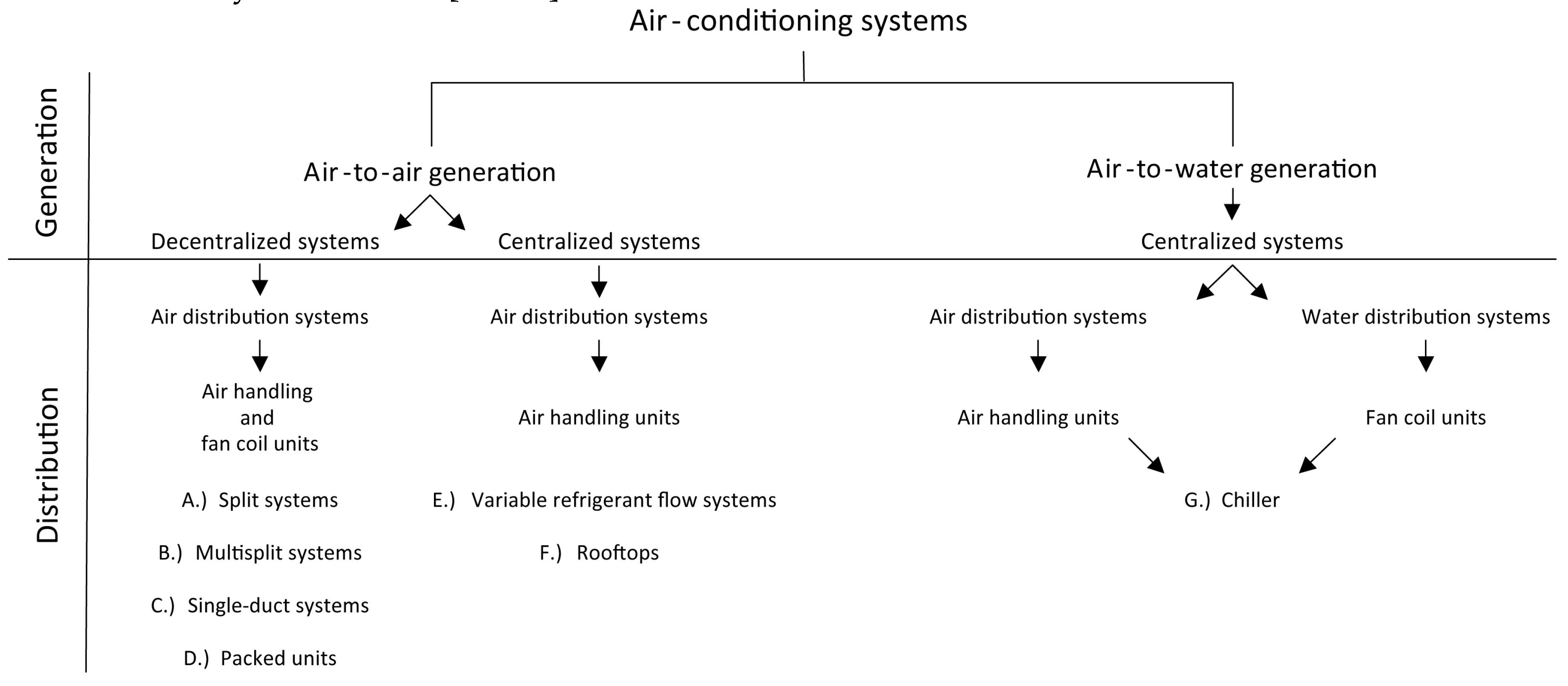


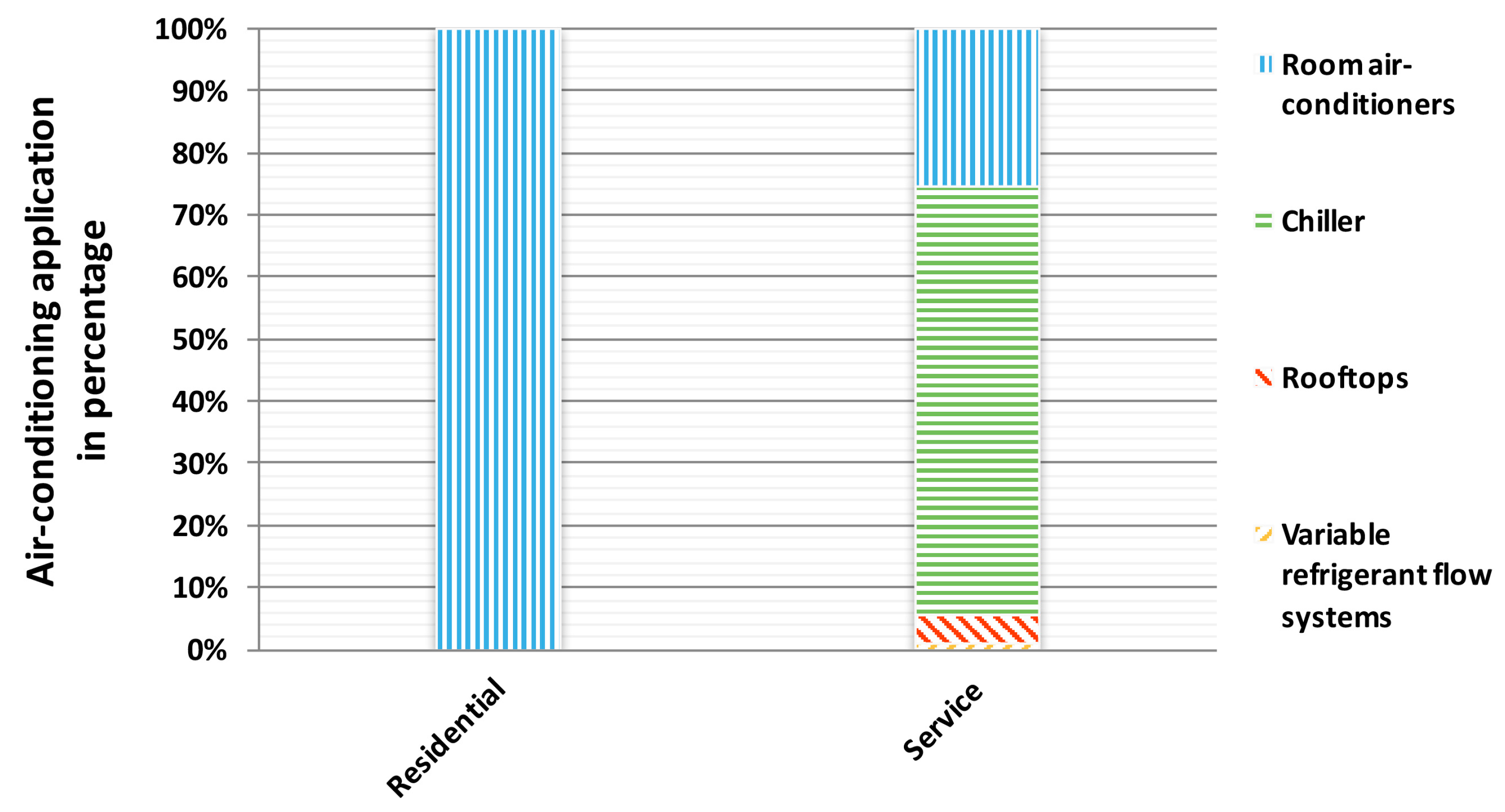
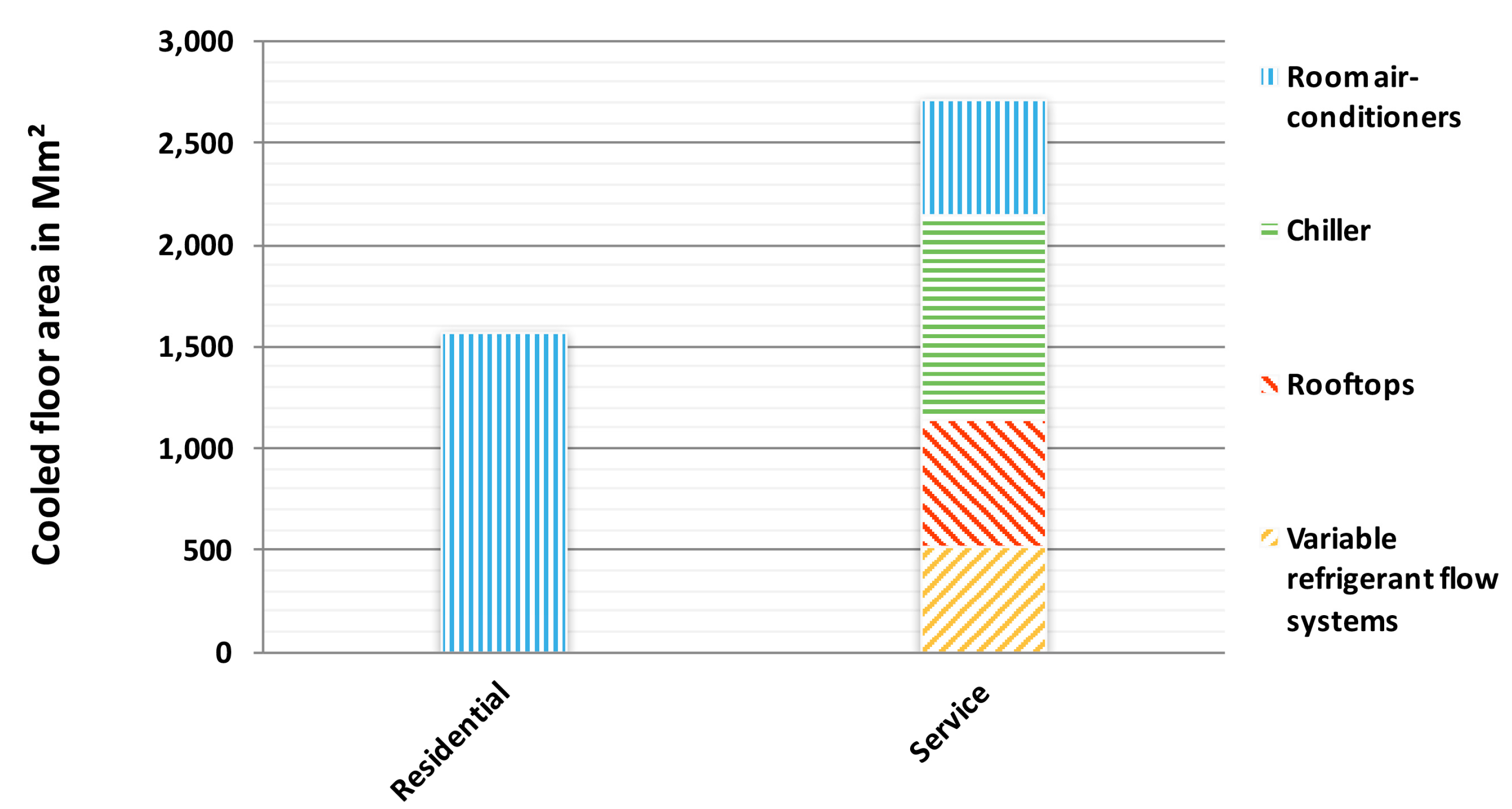
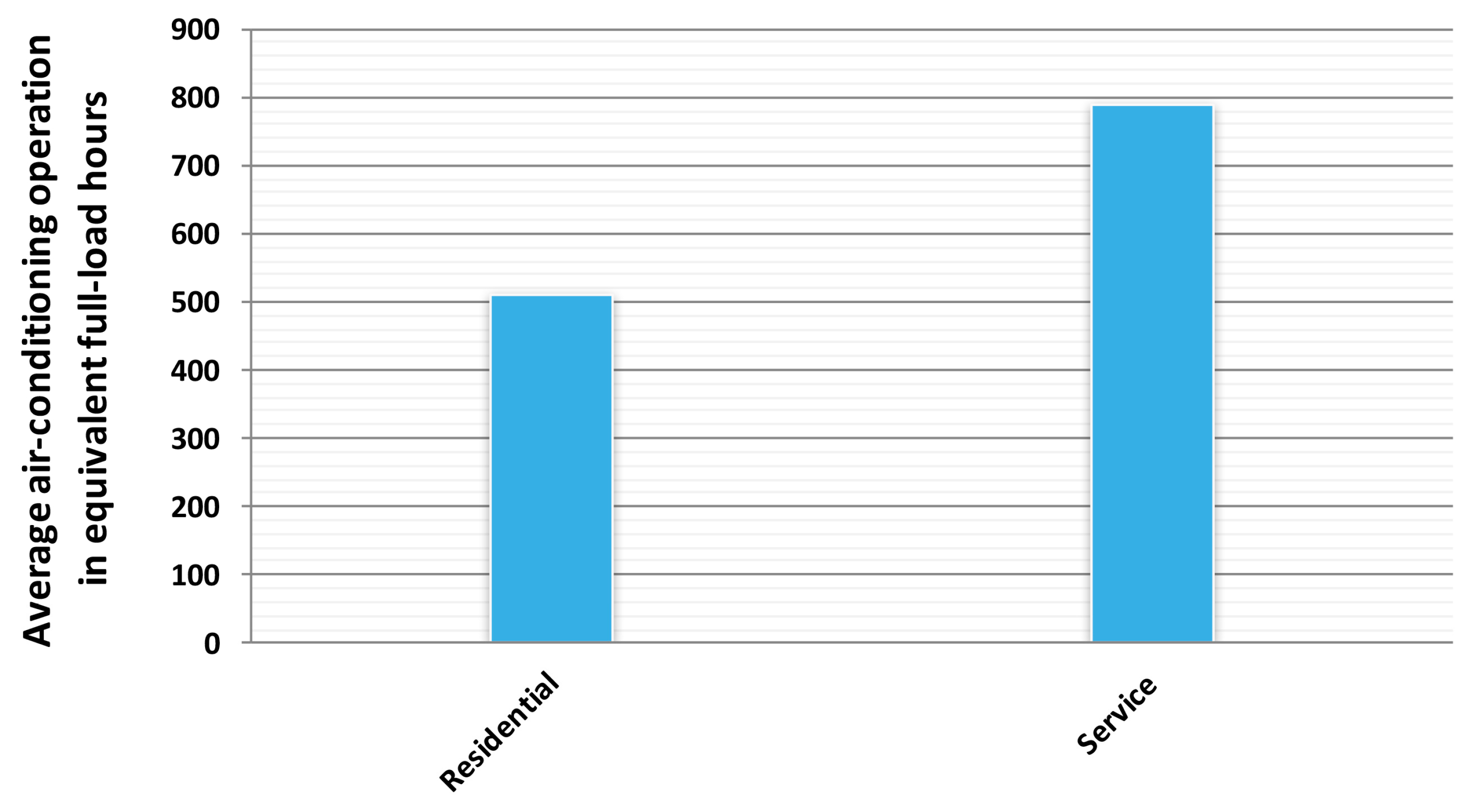
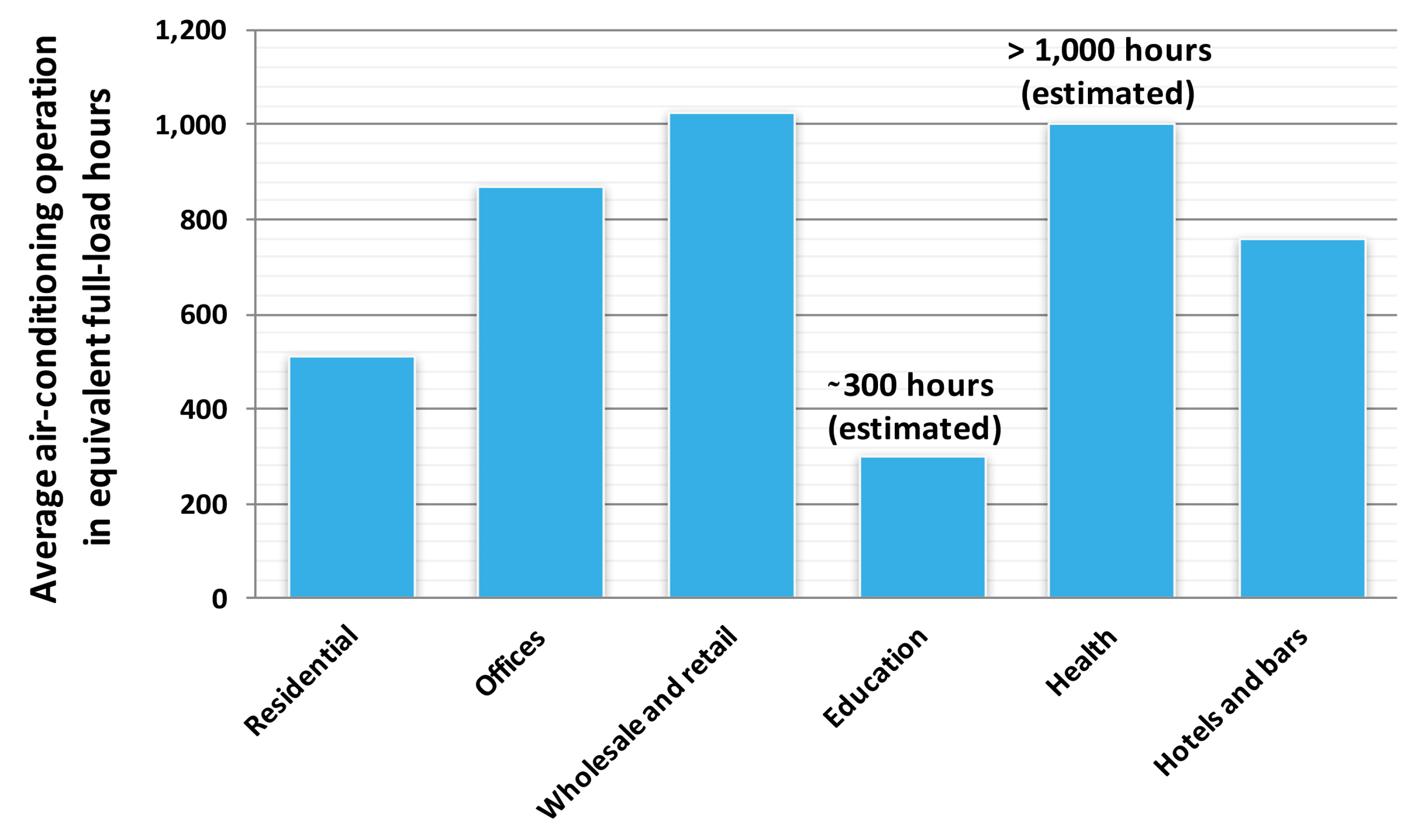
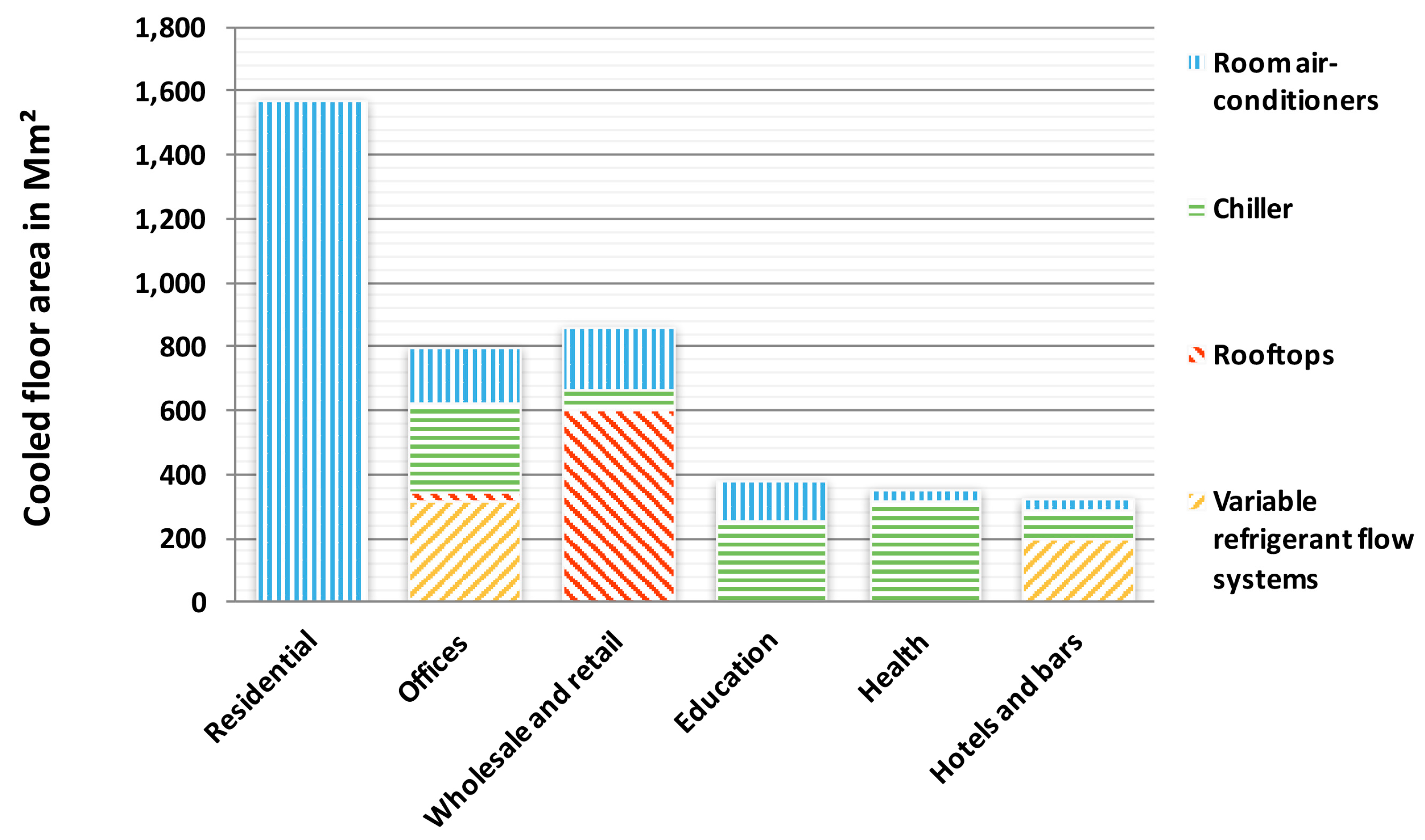
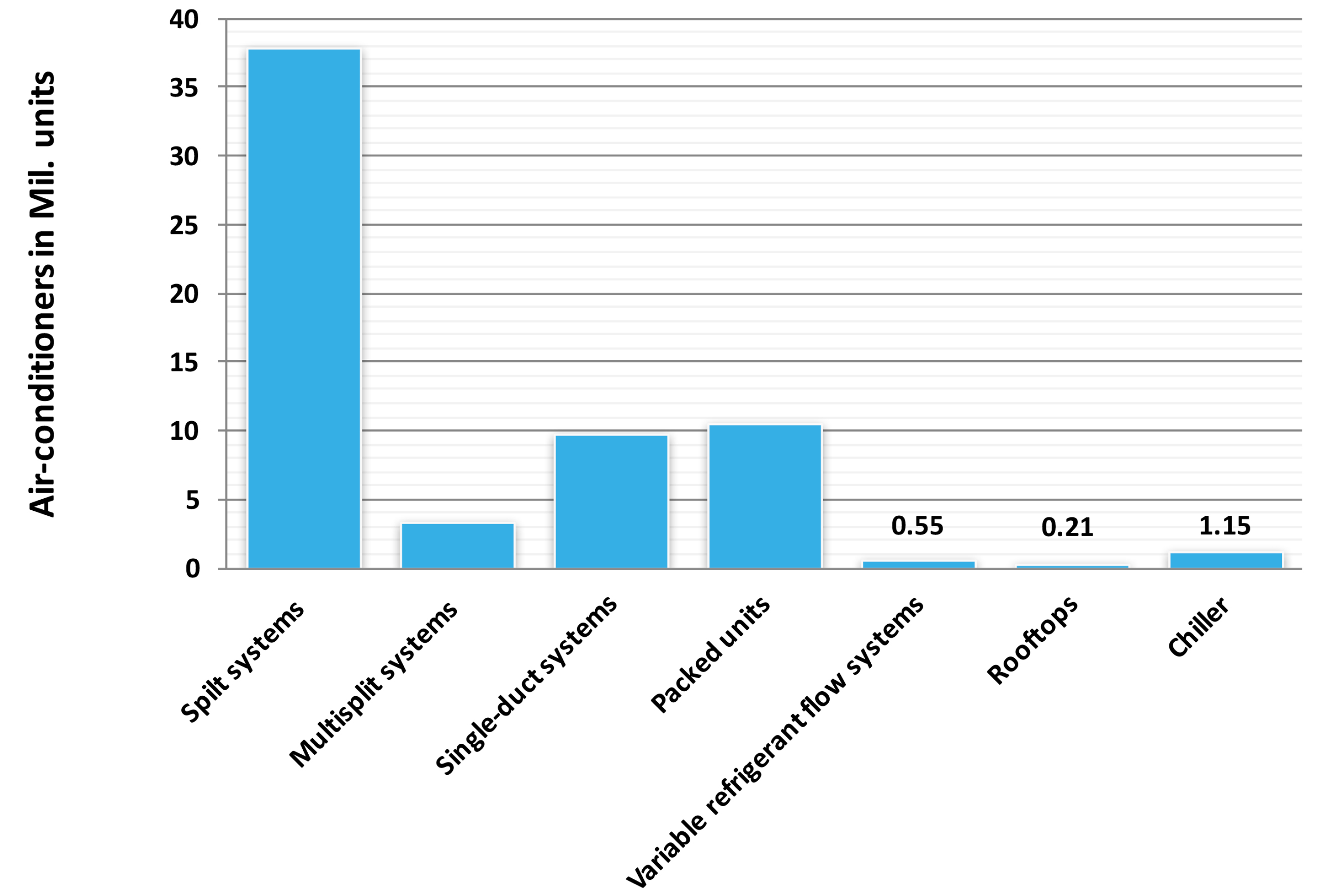
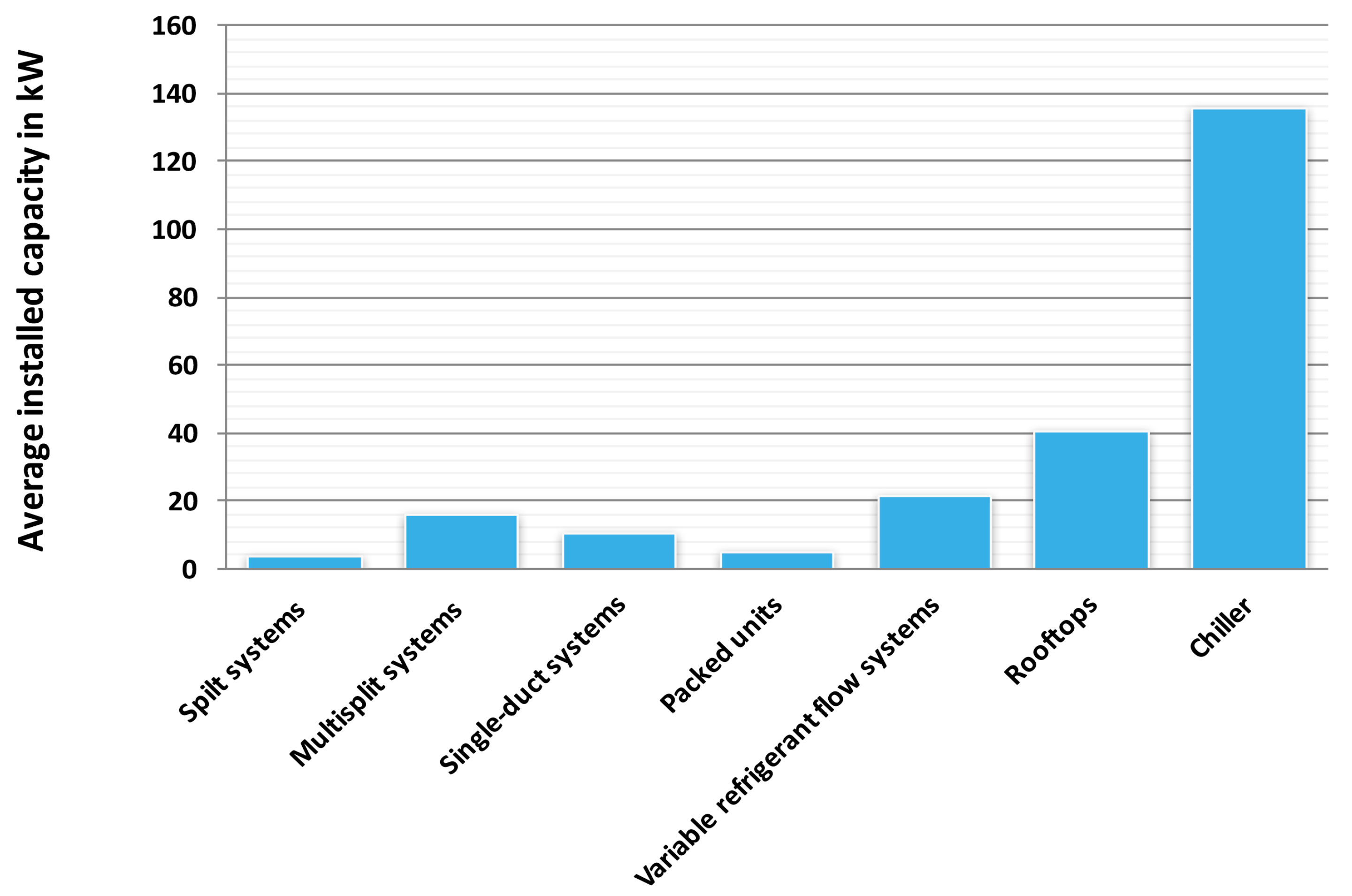
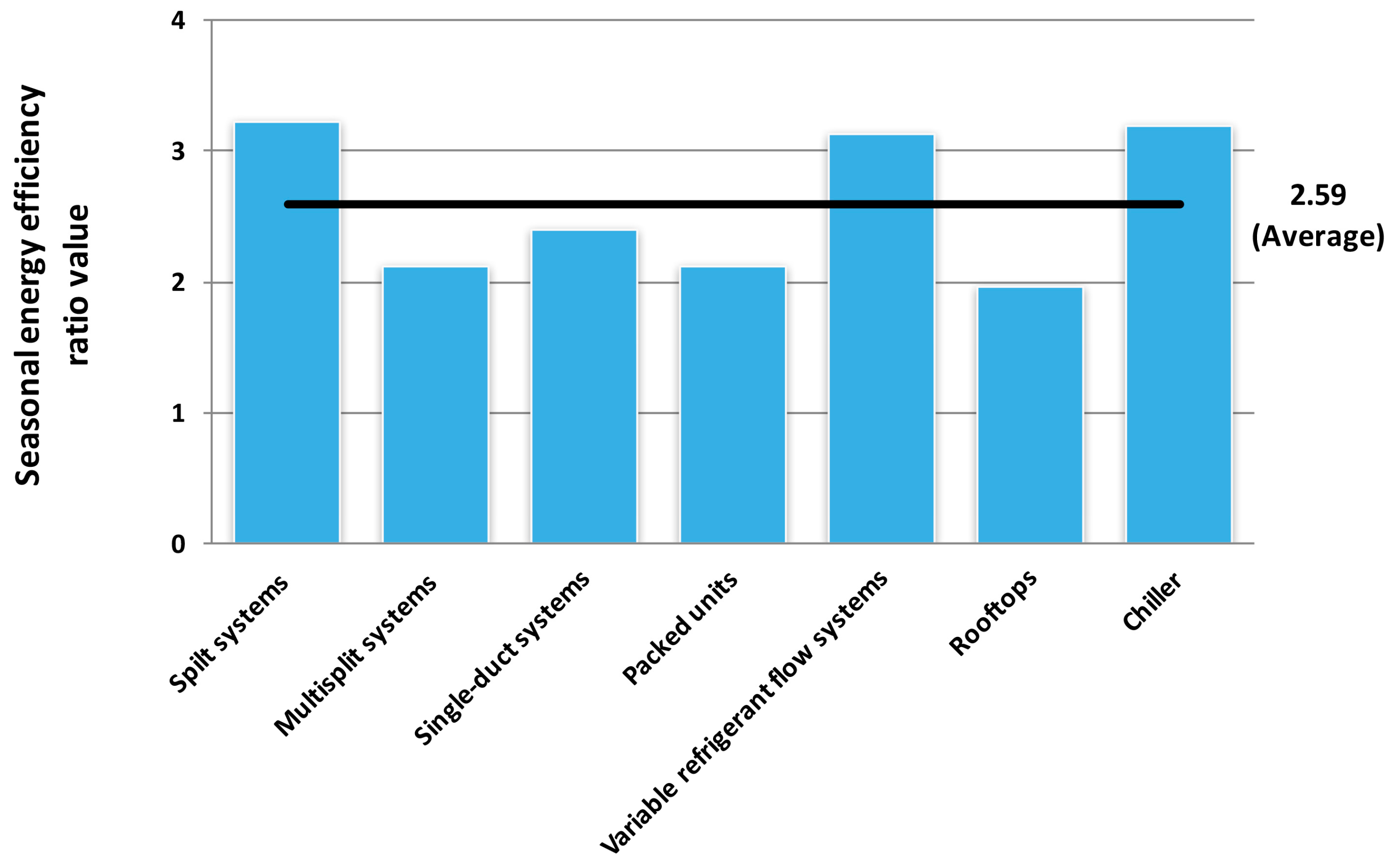

© 2017 by the authors. Licensee MDPI, Basel, Switzerland. This article is an open access article distributed under the terms and conditions of the Creative Commons Attribution (CC BY) license (http://creativecommons.org/licenses/by/4.0/).
Share and Cite
Pezzutto, S.; De Felice, M.; Fazeli, R.; Kranzl, L.; Zambotti, S. Status Quo of the Air-Conditioning Market in Europe: Assessment of the Building Stock. Energies 2017, 10, 1253. https://doi.org/10.3390/en10091253
Pezzutto S, De Felice M, Fazeli R, Kranzl L, Zambotti S. Status Quo of the Air-Conditioning Market in Europe: Assessment of the Building Stock. Energies. 2017; 10(9):1253. https://doi.org/10.3390/en10091253
Chicago/Turabian StylePezzutto, Simon, Matteo De Felice, Reza Fazeli, Lukas Kranzl, and Stefano Zambotti. 2017. "Status Quo of the Air-Conditioning Market in Europe: Assessment of the Building Stock" Energies 10, no. 9: 1253. https://doi.org/10.3390/en10091253






